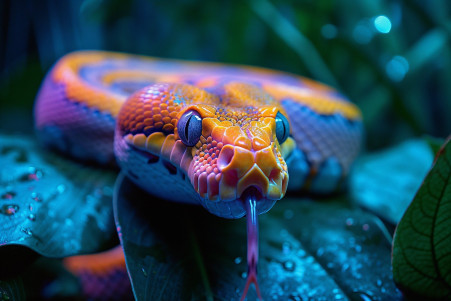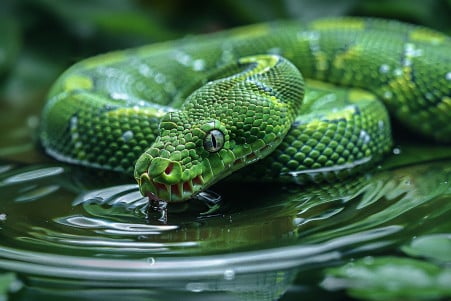Do Snakes Have Cold-Blooded Physiology? The Science of Snake Thermoregulation
26 April 2024 • Updated 24 April 2024

If you think of snakes as cold, slimy reptiles, you're only half right. In reality, a snake's body temperature is heavily dependent on its environment. Snakes are ectotherms, which means they can't regulate their body temperature internally. Instead, they rely on external sources like the sun or warm surfaces to warm up, which in turn allows their metabolism and activity levels to rise and fall with the temperature.
In this article, we'll take a deep dive into the scientific literature from herpetology, zoology, and comparative physiology to better understand the nuances of snakes' cold-bloodedness. This inquiry will shed light on everything from their thermoregulation and energy conservation strategies to the way temperature impacts their reproductive cycles and the unexpected physiological adaptations that come with being an ectotherm. This scientific perspective will help you see snakes in a whole new light.
Are snakes cold-blooded?
How Snakes Regulate Their Body Temperature
As ectotherms, snakes depend on external temperatures to maintain their body temperature. They use a variety of behavioral methods to maintain the ideal body temperature, which is usually between 20-35°C. One of the most common ways is to bask in the sun, which allows them to warm up and increase their metabolism, giving them more energy to do things like hunt.
If the temperature gets too hot, snakes will find shade or dig into the ground to avoid overheating and the damage that can come with it. Some snakes also use countercurrent heat exchange, which is when warm blood from the center of the body warms up cooler blood from the periphery, which helps them maintain their body temperature. Snakes also use evaporative cooling through their mouths and skin to cool themselves down.
In the coldest parts of the year, many snakes go through hibernation or brumation, which slows down their metabolism so they can conserve energy when they can't find food. These methods of thermoregulation help snakes live in a variety of environments by adjusting their behavior and physiology to the temperature. They also give us a better understanding of how these cold-blooded animals have evolved.
Pros and Cons of Ectothermy
Ectotherms like snakes have much lower food and energy requirements than endotherms because they don't use energy to maintain body temperature. Per the Britannica, ectotherms' lower metabolic rates also mean they can go longer between meals, which has helped them survive in environments where food is scarce.
On the other hand, because ectotherms rely on the environment to regulate their body temperature, they are more susceptible to temperature changes. As The Washington Post notes, ectotherms need to find shelter or migrate to avoid overheating or freezing because their activity and metabolic rates are directly tied to the temperature of their surroundings. This can be a pro or a con depending on the circumstances.
To help them deal with temperature changes, ectotherms have developed a number of strategies, including the production of heat-shock proteins or cryoprotectants that help stabilize their proteins and protect them from the effects of extreme heat or cold. This adaptability has enabled ectotherms to live in a wide variety of environments.
Ectothermic Animal Diversity
Snakes are just one example of ectothermic animals, a category that includes many different species from different taxa. According to Study.com, other reptiles like lizards, turtles, and crocodilians are ectotherms, which means they depend on outside heat sources to help them control their body temperature.
Amphibians, like frogs and salamanders, are ectothermic and are often found in damp areas where they can soak up heat from their environment. Freshwater and marine fish are ectothermic and have to keep their body temperature at a level that's right for their specific environment. Even invertebrates like insects, spiders, and other arthropods are ectothermic and use behavioral techniques like sunning themselves to warm up.
This variety of ectothermic animals shows how common this thermoregulation method is throughout the animal kingdom. Knowing the special adaptations and requirements of these cold-blooded animals is important for understanding the amazing diversity of nature.
Physiological and Behavioral Adaptations
Ectotherms like snakes have evolved a number of physiological and behavioral adaptations to deal with temperature extremes. For example, in hot environments, some species can produce heat-shock proteins that help stabilize their proteins and prevent them from denaturing.
In cold environments, some species can produce and secrete cryoprotectants - ice-inhibiting molecules such as sugars, alcohols, and proteins that lower the freezing point of their body fluids and tissues and prevent ice crystal formation. The wood frog, for example, can survive with up to 70% of its body water frozen during hibernation by producing extra glucose to protect its cells.
In addition, behavioral adaptations, such as finding shelter or burrowing underground, also help ectotherms maintain their body temperature when they are exposed to temperature extremes. These adaptations enable ectotherms to live in a wide range of environments by ensuring that they can maintain the body temperatures they need to carry out their physiological functions.
Real-World Implications and Conservation
Knowing the thermoregulation needs and adaptations of ectotherms, such as snakes, is important for the conservation and management of these animals. Per WorldAtlas, preserving habitats and creating areas with the right temperatures are important for the survival of many ectotherms.
Climate change and habitat loss can lead to the disruption of the thermoregulation that ectotherms depend on, which can lead to the endangerment of many species. Per ScienceABC, smaller ectotherms are less concerned with heat loss, which may be why most cold-blooded animals are small.
When ectotherms are bred in captivity and then released back into the wild, their temperature needs must be taken into account. The San Diego Zoo Wildlife Alliance explains that reptiles, amphibians, and fish are ectotherms that rely on the sun to warm up and regulate their body temperature.
Educational and awareness programs can help people better understand the adaptations and roles of ectotherms, such as snakes, in the environment. Knowing the science behind ectothermy can help people challenge their assumptions and appreciate the amazing adaptations of these cold-blooded animals.
Conclusion: Understanding and Appreciating Ectothermy
Snakes and other ectotherms have evolved a number of interesting traits that allow them to live in a variety of habitats. Their dependence on external heat and their ability to control their metabolism have led to a number of unique advantages and disadvantages. It is important to understand the thermoregulation requirements and abilities of ectotherms in order to help with their conservation and management.
By learning about the diversity and special characteristics of ectotherms, we can gain a greater appreciation for the natural world. This overview of the science of ectothermy has challenged our assumptions and helped us to see the amazing things that these animals are capable of.


